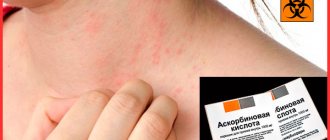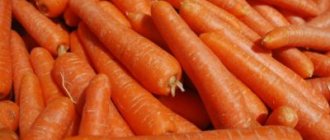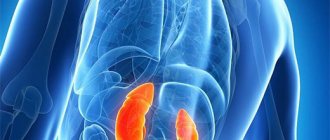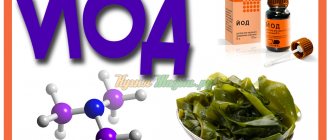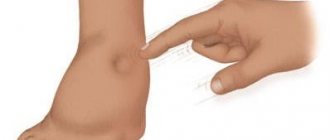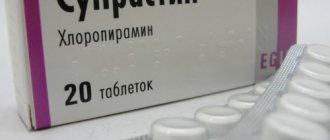Mineral or salt metabolism are processes occurring in the body during which inorganic salts are absorbed, distributed and transformed. The human body needs an uninterrupted supply of water and mineral salts. Different substances occupy different places in terms of importance, but there are the most valuable elements, without which the body’s full functioning is simply impossible. If there is an excessive concentration of certain salts in the body, this condition also provokes disruption of coordinated work and becomes the cause of painful conditions. Let's take a closer look at what types of salts are in the body, and what amount of elements is most optimal.
Causes of salt deposits
A healthy body has the ability to independently remove toxins and heavy compounds. However, under the influence of unfavorable external or internal factors, the natural cleansing mechanism may fail .
The most common reasons for this are:
- kidney and liver diseases;
- abuse of alcoholic beverages, heavy foods, processed foods, fast food;
- lack of water in the diet;
- tendency to over-salt food;
- uncontrolled use of minerals.
In addition, the appearance of deposits can be influenced by:
- genetic predisposition;
- sedentary lifestyle;
- age-related changes;
- general poisoning.
The body of a sick person loses the ability to independently fight the elimination of toxic substances, and excess salt begins to be deposited in the internal organs.
Getting rid of excess salt
It is necessary to normalize the level of salt in the blood as early as possible. If the condition is corrected in a timely manner, dangerous changes will not have time to occur in the body.
Vegetable and fruit juices help a lot. The best juices are pear and carrot juices. They dissolve phosphate and carbonate deposits.
Uric acid salts are very dense and can injure the ureter. This type of deposit should be removed only after consultation with a specialist. A decoction of bay leaves is considered effective. Ten grams of the product are poured with boiling water (two hundred to two hundred and fifty milliliters) and infused for ten to twelve hours. You need to drink the product in small portions for three days in a row.
Getting rid of oxalate deposits is the most difficult thing, but alternative medicine has a lot of effective recipes. A good result is obtained by using infusion of rose hips, pine cones, and grape mustache. Official medicine is also ready to offer different treatment methods. To prevent a serious complication - salt intoxication - the doctor may recommend taking pharmacological agents: "Urodan", "Atophan", "Urosin".
Symptoms
The human body often sends a signal about trouble in its internal systems, which manifests itself in the form of a sudden illness.
Symptoms of excess salt in the body are as follows:
- Constant feeling of thirst . If sodium accumulates excessively, the patient's water-electrolyte balance may be disrupted, causing cells to quickly lose fluid, depleting all internal water reserves. That is why a person is tormented by a constant need to drink, which is difficult to satisfy.
- Swelling. The deposition of salts in the body provokes moisture retention, which begins to accumulate in the tissues. This is especially reflected on the face and limbs. The appearance of causeless swelling is the main symptom of an excess of the substance.
- Bloating. This phenomenon often occurs when fluid accumulates. At the same time, the patient’s tissues swell, heaviness and bloating appear in the abdomen. All this can negatively affect the functioning of the heart.
- Need for salty food. It is the craving for salty foods that indicates that a person has excess salt. Having become accustomed to salty dishes, other food seems bland to a person.
- High blood pressure . Salty foods actively affect the kidneys, impairing their excretory ability. At the same time, water, accumulating in the body, provokes an increase in blood pressure, overloads the heart, and negatively affects the vascular system and the brain.
Constant hypertension leads to deformation of the vascular walls, which often results in cardiovascular diseases.
The most important chemical components in the body
Salt
Sodium, magnesium, calcium and potassium are considered very valuable and essential. Sodium is the main element of intercellular fluid. Its concentration in the intercellular environment is six to ten times higher than in the cellular environment. Once sodium enters the body, it enters the bloodstream from the small intestine. The main role of the substance is to balance the water-salt balance, support kidney function and neuromuscular activity. Thanks to the substance, a certain amount of minerals is retained in liquid form in the circulatory system.
Without sodium, many processes in the body cannot occur: with a deficiency of the substance, growth slows down and normal well-being is impossible. It is responsible for the functioning of the nervous system and the transmission of impulses, has a vasodilating effect, and reduces the likelihood of sunstroke. Both deficiency and excess have an extremely negative impact on human health. Therefore, it is important to follow the norm of its use. The kidneys are responsible for the balance of substances in the body.
Potassium is an important element of intracellular fluid; in total, about one hundred and seventy grams of the substance are present in the body. About ninety percent of potassium is found in cells. For proper functioning of the body, it is necessary to consume from two to three grams of the substance per day.
The main source of potassium is plant products. Absorption of the element occurs in the intestines.
The importance of potassium in the body is enormous:
- balances carbohydrate and protein metabolism, produces the production of individual enzymes;
- necessary for complete absorption and synthesis of protein;
- participates in kidney function;
- has a positive effect on intestinal function;
- helps regulate blood pressure.
Read
Is it possible to restore vision in just a week?
The substance is found in plant and animal foods. Calcium is the main element of human bone tissue and teeth. The amount of the required substance depends on age: a growing organism needs a larger volume of the substance at the time of development and formation of the skeleton. The substance is absorbed in the duodenum.
The role of calcium for the body is enormous. It is involved in the formation of the skeleton, affects blood clotting and water metabolism, participates in carbohydrate metabolism, and is responsible for the production of hormones. A lack or excess of a substance disrupts the coordinated functioning of the body. Magnesium is found in the musculoskeletal corset. Morning lethargy and evening agitation are the cause of a lack of substance. To prevent salt deposition in the kidneys and gall bladder, it is necessary to consume the right amount of the component.
Zinc
In addition to the substances mentioned, the following substances are present in the body and are of great importance for health: iron, cobalt, zinc, selenium, silicon. There are also many other elements in small quantities that have not yet been fully studied by doctors and scientists. About seventy elements are responsible for the harmonious and complete functioning of the body. To avoid having to remove excess salts from the body, it is necessary to balance the exchange of mineral salts. Any imbalance leads to product accumulation. This, in turn, provokes the development of various diseases and accelerates aging.
Consequences
Excess salt in the body negatively affects the main organs that perform a number of vital functions - muscle tissue, heart, blood vessels, kidneys and the central nervous system:
- an excess of the compound leads to weakening and stretching of muscle fibers, affecting their contractile activity;
- The kidneys are under a lot of stress. Deposits can provoke kidney failure, inflammatory processes, nephritis ;
- excess salt often causes blood thickening, which leads to increased blood pressure and increased heart rate. In these cases, the likelihood of arrhythmia, bradycardia, and stroke increases;
- in addition, compounds can affect the functioning of the brain and hypothalamus, disrupting the process of regulation and conduction of nerve impulses.
If the human body suffers from an overabundance of the substance for a long time, serious consequences can occur that affect all internal systems:
- Osteoporosis. Excessive salt accumulation leads to loss of calcium found in the bones, which provokes their thinning and the development of this disease.
- Stones in the kidneys. The kidneys are the main organ of the excretory system, which removes excess fluid from the body. If a person has a lot of salt in the body, the kidneys stop functioning normally, which often ends in the formation of calcium stones.
- Malignant tumor of the stomach. Excessive consumption of salty foods increases the likelihood of developing stomach cancer by about 10% .
Most often, this pathology occurs among the Japanese, where the most popular food is various pickled and salty dishes.
Diuretics from nature
If you are going to eat diuretic foods, be sure to drink more water to avoid dehydration.
Most people are interested in what foods remove salts, it turns out that they are nearby - in the refrigerator, on store shelves, you just eat them in the wrong quantities, in the wrong form, or simply ignore them.
Natural diuretic products:
- Beet;
- Asparagus;
- Watermelon;
- Greenery;
- Dried apricots;
- Sea kale;
- Raisin;
- Almond;
- Lentils;
- Coffee;
Attention! Coffee increases blood pressure, so people with hypertension should avoid it.
How to identify the problem
With a metabolic disorder, the following types of deposits can accumulate in the human body:
- Oxalates are solid substances that are often the cause of stone formation. Capable of settling in any internal organs . It is quite difficult to extract oxalates.
- Alkaline compounds most often accumulate in the joints and spine, causing disorders of the musculoskeletal system. These include phosphates and carbonates.
- Urates are often localized in the lower extremities. Uric acid salts are manifested by swelling of the legs, bumps, pain symptoms, and the development of arthritis.
Excess salt can be detected without resorting to laboratory diagnostic methods. To do this, the patient should collect the morning portion of urine in a container, leave it for 24 hours, and then carefully examine :
- when a white sediment appears in urine, the presence of carbonates can be suspected;
- small shiny crystals indicate phosphates in the urine;
- if the crystals have a reddish or yellow tint, this indicates the presence of urates;
- a large accumulation of brownish-gray crystals may indicate oxalate content in the urine.
Long-term effects of excessive salt consumption
Our organs signal us in every possible way about the danger of high salt content in the body. If we stubbornly ignore them, we may end up with even bigger problems over time. The long-term effects affect our kidneys, skin, heart, stomach and bones. Edema, kidney stones, stomach cancer, osteoporosis are the most common consequences of excess salt.
Osteoporosis
Proper nutrition and good digestion are very important for the prevention and treatment of osteoporosis. If there is an excess of salt in the urine, a lot of calcium, which is taken from the bones, is washed out of the body. Excretion of calcium along with urine causes osteoporosis - thinning of bone tissue.
Stones in the kidneys
The kidneys first collect waste water and then remove it from the body. Excessive salt intake complicates this process, resulting in much less water being excreted. Kidney stones form from calcium found in urine. And calcium excretion increases precisely when we consume too much salt.
Stomach cancer
Highly salty foods can increase the risk of developing stomach cancer. At the same time, it becomes clear why residents of Japan especially often suffer from this disease, where salted and pickled foods are very popular. For those people who like to indulge in “salty” foods, the risk of being diagnosed with stomach cancer increases by 10%.
Methods for removing deposits
Cleaning internal organs of compounds will not be difficult if their excess has not yet provoked serious complications. Otherwise, medical care is vital.
To avoid severe pathologies, each person is recommended to carry out preventive cleansing of toxic substances and excess salts at least once a year..
Before carrying out cleansing measures, it is necessary to remember that any procedure puts additional stress on the urinary tract. That is why it is necessary to make sure that there are no contraindications to cleaning.
Deposit removal is carried out starting with light alkaline compounds, moving to heavier ones.
Removal of alkaline deposits
Light salt accumulations are eliminated from the body quite simply. For this, natural alkaline solvents are used: carrot or pear decoction, as well as an infusion of sunflower roots .
To prepare the infusion, pour 1 liter of boiling water over 100 g of roots. Use the resulting product for 30 days. During the cleaning process, the color of the urine should be monitored: it should become more transparent and free of sediment.
In addition, during cleansing it is necessary to exclude spicy foods, salty and sour foods from the diet .
You can remove excess salt from the body using the following recipes:
- For 30 days, the patient should consume infusions prepared from freshly squeezed carrot juice, spinach and aloe. The components are taken in a ratio of 5:3:1.5. The resulting product is drunk 1 liter per day.
- Black radish will help cope with an excess of alkaline deposits. To do this, 10 kg of radish are crushed with a juicer. Use the product starting from 5 g per day, gradually increasing the daily dose to 30 g.
During cleansing, you may experience pain in the head, increased blood pressure, and chest pain. However, you should not be afraid of these symptoms: they indicate the beginning of the cleansing process.
Urate extraction
Uric acid is not easy to extract; these salts are quite harsh and can irritate the urethra. That is why procedures are carried out in the absence of diseases of the urogenital tract .
Excess urates can be extracted in the following ways:
- For preparation you will need knotweed, currant leaves and strawberry leaves in a ratio of 1:2:2. The plants are crushed, pour 200 g of boiling water and leave for 30 minutes. The decoction is drunk 4 times a day. The duration of the cleansing is 30 days.
- Bay leaves are poured with boiling water, put on moderate heat and wait until it boils. The broth is boiled for 5 minutes, then placed in a warm place and kept for 4 hours. Bay infusion should be drunk 3 days in a row in small portions .
Do not consume the entire solution at once: it may cause internal bleeding. In addition, bay leaves are contraindicated for people with stomach ulcers and severe liver diseases.
Oxalate extraction
Solid salt deposits are quite difficult to remove, but possible. You can get rid of salt deposits using the following recipes:
- For preparation you will need a grape mustache. 1 teaspoon – per 200 g of boiling water. The decoction is kept for 30 minutes and taken 1/4 cup for 30 days. After a break of 10 days, the cleaning course is repeated.
- An excess of heavy compounds can be eliminated by regular rice. For 75 g of rice grains - 1 liter of water. The solution is left to stand for a day, the water is drained and fresh water is added. After this, boil the rice for 5 minutes, cool and drain the water again. Repeat the procedure 2 times. Cooked rice is consumed instead of regular food once a day, every day, for 2 weeks. Cereals prepared using this method absorb excess salt and extract it naturally.
- Infusions from pine cones are excellent at dissolving salt accumulations in arthritis. Spruce or pine cones contain special components that destroy heavy compounds. These decoctions are taken daily for 3-4 weeks.
- You can cleanse your kidneys with rose hips . For this you will need: 1/2 cup of rosehip infusion, 200 g of aloe leaves, 30 g of sugar. Aloe is finely chopped, combined with granulated sugar, left for an hour, after which rose hips are added. The resulting syrup is filtered and consumed 10 g three times a day.
How much salt can you eat per day?
Most of us use salt every day. And few people know how to control the amount of this spice in their diet.
Table salt contains 60% sodium and 40% chlorine. A simple calculation can determine that one teaspoon of salt contains approximately 2000 mg. sodium
The recommended daily dose of sodium for a person is 2300 mg, that is, a little more than in one teaspoon. But according to statistics, we exceed this norm at least twice every day. But an excess of salt in the body can have a very negative impact on health.
It is important to pay attention to the warning signs that the body uses to signal us that we are consuming too much salt.
Diet
When conducting a cleansing course, you should follow some recommendations:
- you need to eat in small portions, fractionally - up to 6 times a day;
- reduce salt intake to 1.5 g daily;
- replace table salt with sea salt;
- do not eat food containing additives and dyes;
- exclude fatty meat and fast food from the diet;
- drink more water – up to 2 liters per day;
- limit your intake of sweets;
- take medications that normalize microflora.
Some products help cleanse internal organs of excess salt. These include:
- seaweed;
- cereals;
- vegetables;
- green tea;
- legumes;
- sunflower oil;
- seafood;
- eggs;
- fruits;
- nuts.
The easiest way to reduce the amount of salt consumed is to give up unhealthy foods and fast food, switching to fresh vegetables and fruits..
Of all the food that a person consumes, only 25% is pure salt. The body gets the remaining 75% from purchased products.
Before purchasing, you must carefully read the composition and identify the sodium content: it is this that can cause excess salt. Some seasonings will help replace the substance: red or black pepper, wine vinegar, lemon juice.
How to remove excess salt from the body
Methods for removing salt depend on how serious the situation is. It is better to consult a doctor rather than self-medicate.
Removal methods
The simplest option is diet. It is necessary to create a menu in which one meal will contain up to two grams of salt and no more. It is important to exclude fast food.
Drug treatment is possible: the doctor prescribes drugs that accelerate the excretion of salt and prevent its accumulation in the body, as well as a vitamin and mineral complex. Hospitalization is carried out in the most severe cases.
Salt composition and features
In ancient times, salt was extracted from brines located in the bowels of the Earth. It was hard manual labor. People stood in cold water for hours, pumping out the brine. Then it was boiled and the finished salt was obtained. Sodium chloride was produced in small quantities, was expensive, and was used as a seasoning. Technological progress has made significant adjustments to both production volumes and the cost of the product.
Today, salt is an important ingredient in the human diet. It is present in most first, second and even third courses, is used in finished products, and is used in canning.
Without her, there would be no herring and lard, pickles and mushrooms, roach and cheese, feta cheese and much more on our table. A strong natural preservative, it preserves foods and gives them a special taste.
What is salt? It contains no proteins, carbohydrates, fatty acids, or vitamins. In terms of its chemical composition, it is a combination of sodium and chlorine crystals. So why can’t we live without it, why do we add it to food.
It's all about the taste that sodium chloride gives to foods. Without it, dishes will seem bland and unappetizing. White crystals create real magic, and we add salt, add salt, season it. Is there any benefit to salt for our body, and what is its harm?
Every day, picking up a hodgepodge with a long-familiar and cheap seasoning, no one thinks about the history of the origin of its contents.
Even ancient people felt the benefits of salted food - its taste became richer, and the shelf life of foods treated with salt increased significantly. But salt in those distant times was not known in its pure form. Some claim that its substitute was ordinary ash from a fire, which accidentally settled on meat fried over the fire and gave it a pleasant salty taste.
According to other sources, mankind’s first acquaintance with salt most likely occurred on the shallow shores of the seas. Due to the high temperature, rapid evaporation of water and the influence of wind, a sediment with a high concentration of salt was formed.
It is not known for certain who is right, but salt has firmly entered human life and is the most popular seasoning.
The culinary properties of salt were well known to the ancient Egyptians and Babylonians.
With the increase in population, salt consumption has also increased significantly. People began to look for different ways to obtain this useful product. According to scientists, the first salt mining began in Ancient China 5 thousand years ago.
About a thousand years before the birth of Christ, salt began to be mined in the territory of modern Austria.
The main sources were rare deposits of rock salt and salt water from the seas. In the southern part the water was evaporated, and accordingly in the northern part it was frozen out. These two methods were equally expensive, which affected the cost of salt - it was incredibly expensive, sometimes more expensive than gold.
The 12th-17th centuries saw the heyday of the salt trade. In places where it was impossible to obtain salt, it was delivered by caravans. Trade in white crystals provided huge flows of precious metals from gold and silver to both traders and the state treasury. Often it was exchanged for various goods, slaves, and land. Salt was treated very carefully and stored only in special caskets.
Although there are more than enough salt deposits in Rus', there was a time when it was inaccessible to mere mortals.
Like most spices, salt was very expensive, and wars and civil strife were fought over it. In the spring of 1648, the so-called Salt Riot took place in Moscow, provoked by an excessive tax on salt.
The production process was quite complex and labor-intensive, which explains its high cost.
The white powder that we know well, which we call salt, consists of 97% NaCl, the remaining 3% impurities are carbonates and iodides. To prevent dental diseases, fluoride is often added to salt. Switzerland is the first country to include them in the salt composition. The result obtained in the fight against caries was stunning, and since 1980, France and Germany followed her example.
Another element that can be found in salt is potassium ferrocyanide or E536, a food additive that serves against caking.
In the USA, they practice the production of so-called salt products with a reduced sodium content, by replacing part of it with potassium or magnesium chloride.
Separately, it is necessary to highlight sea salt, which is not characterized by either chemical or organic impurities. It is rich in minerals - K, Ca, Mg, Mn, Fe, Cu, Zn, etc., and it contains 84 elements and 200 chemical compounds.
What foods contain sodium?
The risk of “over-salting” on our dinner tables is greater than cases of “under-salting”, and this is due to the use of ready-made and semi-finished foods in the diet. The source of sodium chloride are cheeses, sausages, bread, canned food - they satisfy the basic need for salt; we take only a quarter of the food additive from the salt shaker. The adult body requires 4-6 g of sodium per day. The products presented in the table contain it in large quantities.
Table: sodium in food
| Product Name | Na content (mg/100g product) |
| Cereal products | |
| Rye bread | 430 |
| White bread | 250 |
| Butter loaves | 240 |
| Cornflakes | 660 |
| Vegetables | |
| Sauerkraut | 800 |
| Canned beans | 400 |
| Mushrooms | 300 |
| Beet | 260 |
| Celery | 100-125 |
| Berries and fruits | |
| Dried grapes | 100 |
| Bananas | 54 |
| Dates | 20 |
| Currant | 15 |
| Apples | 8 |
| Dairy products, eggs | |
| Milk | 120 |
| Eggs | 100 |
| Cottage cheese | 30 |
| Cheese | 800-1200 |
| Meat fish | |
| Beef, pork | 80-100 |
| Fish | 50-100 |
| Tuna canned | 500 |
When adding salt to food, you should always take into account that the necessary sodium is already present in food products, and its excess is harmful.
Traditional recipes for treating salt
The beneficial properties of salt in the treatment of some external problems of the body are well known. Every grandmother knows where and how to apply hot salt in a cloth. And he will tell his granddaughter about it and show it.
- Among the popular folk recipes, everyone is familiar with treatment using hot salt poured into a cloth or bag. An improvised compress will relieve a cold from a runny nose, and when cooled, it will also relieve a headache if you apply it to your temples.
- The same bag will straighten your back during radiculitis and relieve pain. But to treat osteochondrosis, you need to mix salt and mustard, dilute with water, heat it and apply it to the affected area. A week-long course with such lotions improves mobility and the pain goes away.
- If you are tired of fighting fungal infections on the skin of your feet, salt will help you. Wipe your feet with a cloth soaked in saline solution, then take a soda bath, and after two weeks the fungus will leave your skin.
- If you want to remove bags under your eyes, prepare a salt compress. Dilute a teaspoon of sodium chloride in one liter of water, soak gauze or a cotton pad in the resulting solution, apply it to the lower eyelid area, and hold for 10-15 minutes.
- Use salt as a natural scrub to rid your skin of acne and blackheads. Of course, there is no need to rub your skin with salt, but wiping them with a cloth soaked in a strong saline solution is useful. Sodium chloride has strong antibacterial properties, it relieves inflammation and normalizes excretory processes.
We have spoken enough praises of white crystals of sodium chloride, it’s time to learn about the harmful properties of salt.
